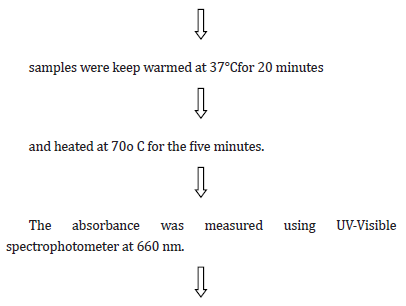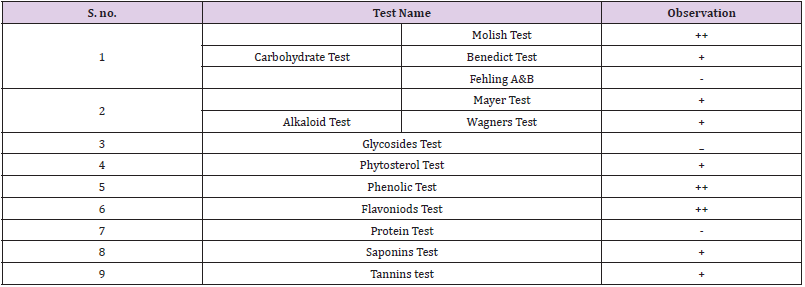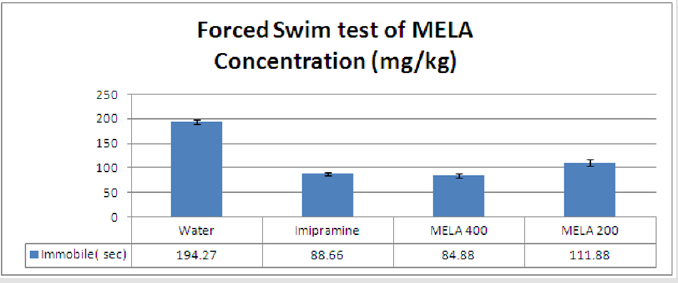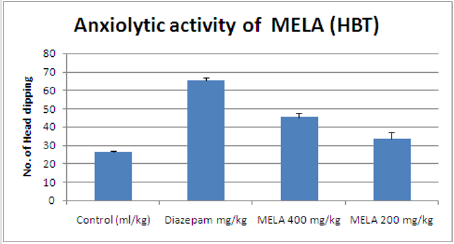Abstract
The core aim of the current research study was expose the in-vitro Anti-Inflammatory along with in-vivo Anxiolytic actions of methanolic extract of the Leea aequata Leaves under the family of Vitaceae. Leaves of the plant Leea aequata were collected from KEPZ Hill tract area, KEPZ, Chittagong, Bangladesh in the month of January 2018. This has been created that plants which also naturally synthesis as well as collect some of the secondary metabolites such as alkaloids, volatiles oils, glycosides, tannins, as well as contain minerals and also vitamins, have medicinal properties. Mainly phytochemical test of plant extract must be prepared for ensuring the existence of bioactive constituents of plant extract. This is primary phase of plant for work. Later than screening of phytochemicals of plants, it can presume the next phases what must to do with the plant extract. Here after screening of the Leea aequata it was observed positive results for the carbohydrates, Phytosterols, Flavonoids, Phenols, Tannins in addition to Saponins which must be good signs for advance research study with this plant. Here the plant Leea aequata having improved result on in vitro Anti-Inflammatory effect in Egg Albumin assessment. It has enhanced neuropharmacological value also. It also demonstrates superior effect on Anti-Depression in addition to anxiolytic.
Keywords: Leea Aequata; Anti-Inflammatory Effect; Anti-Depression and Anxiolytic
Introduction
The plant that have therapeutic actions or wield beneficial pharmacological outcomes on animal bodies are usually assigned as “Medicinal Plants”. While there is no perceptible morphological property in medicinal plants producing with them, so far they have several special qualities that create them medicinally so important. Plant is someone of the huge number of life forms within biological kingdom of Plantae; generally, these classes are regarded as of partial motility as well as generally produce their individual food. They comprise a host of well-known organisms together with trees, grasses, forbs, shrubs, vines, ferns in addition to mosses [1]. Traditionally the word plant implies that a taxon with properties of multicellularity, cell structure along with walls holding cellulose in addition to organisms competent of photosynthesis [2]. The plant Leea aequata is usually used in tribes regions for Astringent, Antipyretic, Anthelmintic, Alexiretic [3]. This is also helpful in Bronchitis, Dyspepsia, Anaesthesis of the skin, Bilious fever, Itching, Leprosy, Tuberculous and Ulcer. This is also recognized as a Kakjangha in the Bengali [4]. As it is known that inflammation is the complex method which is normally associated with the pain and involves incidences like the raise of the vascular permeability, raise of the protein denaturation in addition to membrane alteration [5]. Cells in body are harmed by microbes, chemical agents, physical agents, the damage is in form stress. Inflammation of the tissue is because of reply to stress [6]. Loss of task happens depends on site in addition to extent of the injury [7]. In view of the fact that inflammation is one of body’s nonspecific inner systems of resistance, the reaction of the tissue to accidental hack is analogous to the reply that consequences from other sorts of tissue injure, reasoned by burns because of heat, radiation, viral or bacterial attack [8]. The duration of an nervous feeling can for a while be out of the proportion to original trigger, Physical symptoms like enlarged blood pressure in addition to nausea, can also happen to evident [9]. These answers move further than anxiety into anxiety disorder. So anxiety disorders happen when a result is out of the proportion to what might usually be supposed in a condition [10]. The main aim of the present research work was find out the In-vitro Anti-Inflammatory and In-vivo Anxiolytic properties of the methanolic extract of Leea aequata Leaves (Figures 1 & 2) & (Tables 1 & 2).
Table 1: Phytochemical Screening of Leea aequata.
Note: showed in (Table-3).
(+)= Present,(++)= Rapidly present
(-) = Absent.
Materials and Methods
Animals
Mice weighing about 28-32 gm aged about 1.5 month were purchased from animal house of Department of Pharmacy, Jahangirnagar University, Savar, Dhaka, Bangladesh. All the animals were acclimatized to new environment for a period of one week. During the test period the animals were kept in a well ventilated animal house at 250C. They were supplied with standard pellets and fresh drinking water. All the mice were kept in cage and maintained with natural 12h light and dark cycle.
In-vitro Anti-Anti-Inflammatory Activity of Leea Aequata Egg Albumin Denaturation Method
The anti-anti-inflammatory activity of methanolic extract of a plant was studied using the following procedure was followed by many authors [11] for evaluating the Percentage of inhibition of protein denaturation (Figure 1). The reaction combination was consisting of trial extract at unusual concentrations. pH of reaction combination was regulated using small quantity of 1N HCl. The trials were hatched at the 37ºC for 20 min. in addition to heated for 57ºC for 2 min. Later than cooling the trials, turbidity was determined by spectrophotometrically at the 416 nm [12]. The test was done triplicate. The percentage (%) inhibition of the protein denaturations were considered as follows:
% of Inhibition =  Where,
Where,
AO = Absorbance of the control
A1 = Absorbance of the sample
Preparation of the Phosphate Buffer Saline (PH 6.3)
1. Transfer 8 g of NaCl, 0.2 g of KCl, 1.44 g of dipotassium
hydrogen phosphate and 0.24 gram of the potassium dihydrogen
phosphate to a one liter standard flask
2. Dissolve in 800 ml of DW water.
3. Adjust the PH to 6.3 using 1N Hydrochloric acid and
framework the volume to 1000 ml with the distilled water
(DW).
Preparation of Control Solution (50 ml)
2 milliliter of egg albumin, 28 milliliter of phosphate buffer (pH 6.4) and 20 ml distilled water.
a. Preparation of Standard drug (50 ml)
b. It consists of 2 ml of egg albumin, 28 ml of phosphate
buffer and various concentration of standard drug (Diclofenac
Na) concentration of 100, 200, 400 and 800μg/ml.
c. Preparation of test solution (50 ml)
d. It consists of 2 ml of egg albumin, 28 ml of phosphate
buffer and various concentration of plant extract concentration
of 100, 200, 400 and 800μg/ ml.
Procedure
50 ml various concentrations (800,400,200,100 μg/ml) of test solution and standard drug diclofenac sodium solution (800,400,200,100 μg/ml) were taken respectively.

The control signifies 100% of the protein denaturation. The consequences were balanced with the diclofenac sodium. The percentage reticence of the protein denaturation can be computed as.
In-Vivo Antidepressant Test
Tail Suspension Test (TST): The end suspension technique used in study was analogous to those mentioned by some authors [4]. Treatment was provided 60 min prior to the study as mentioned by study design. Mice were shelved on edge of table, 50 cm higher than the floor, with help of the adhesive tape positioned around 1 cm from tip of tail. The total extent of immobility persuaded by end suspension was evidenced throughout 6 min of 10 min period. Animal was regarded as to be immobile at what time it did not confirm any progress of body, hanged inactively and entirely motionless [5].
Forced Swim Test (FST): For forced swim test (FST), mice of either gender were separately forced to the swim in open cylindrical pot it’s is diameter 10 cm, height 25 cm holding 19 cm of water at the 25±1°c. Treatment was provided 60min prior to the study as mentioned by the study design. Animals were forced to the swim for 7min in addition to the extent of the immobility was monitored and determined during final 5min interval of test. Here each mouse was the judged to be motionless when this ceased struggling in addition to remained floating immobile in water, making those associations to stay its head on top of water. A reduce in duration of quiet is pinpointing of the antidepressant effect (Table 3) [5].
Table 3: Effect of the Methanolic extract of Leea aequata on anti-depression test on tail suspension test in mice. Values are expressed as mean ± S.E.M., (n = 6).
MELA=Methanolic Extrac of Leea aequata.
In-vivo Anxiolytic Activity of Leea Aequata: Depending on
mechanism, techniques for evaluation of the anti-inflammatory
activity of samples can be determined by following two ways:
a. Hole board test
b. Elevated plus maze test
Hole Board Test (HBT)
Procedure: The method mentioned by some authors [4] was approved for testing the Central Nervous System (CNS) movement of the methanol fruits extract of the plant. The research study was performed using the wooden hole-board measuring 20 centimeter by 40 cm with 16 consistently spaced holes and each of diameter is 3 cm. The equipment was raised to the height of 25 centimeter. 30 minutes later than treatment, mice were situated singly on center of board in addition to number head dipping as well as latency until first entrance was calculated using counter during the 5 min test period [4].
Elevated Plus Maze (EPM) Test Method: Animals were evaluated, numbered in addition to separated into five sets, each consisting 06 mice. One set was employed as control (like saline), second for typical drug (like diazepam) treatment of 3rd 4th. As well as 5th set for the coriandrum extract for the treatment (like Test - 50 mg/kg, 100 mg/kg and 200 mg/kg). Animals were positioned separately in center of maze, and head facing on the way to the open arm in addition to stopwatch was initiated. The following constraints were recorded for the 5 min. First penchant of the mouse to the open or the closed arm. The number of accesses in the open arm. The average time of every animal uses in the open arm was estimated. Saline in addition to diazepam were inserted to control in addition to standard groups correspondingly. The coriandrum of extract was inserted to test groups. Later than 30 min and animals were situated separately in center of maze. Lastly, it was compared preference of animals to the open or the enclosed arm and average time used in the open arm.
Results and Discussion
Phytochemical Screening
The qualitative phytochemical screening was performed to
ensure the presence or absence of secondary plant metabolites. In
our investigation we have found positive results for carbohydrates,
Alkaloids, Phytosterol, Phenol, Flavonoids, Tannins and Saponins.
The result
showed in (Table 3).
(+)= Present,(++)= Rapidly present
(-) = Absent.
In-vitro Anti-inflammatory Activity
The plant extract inhibited the protein denaturation by from a lowest 5% when conc. was 125 μg/ml. To the highest % of inhibition was 35% when concentration was 1000 μg/ml as compared to standard drug diclofenac Na inhibited by 82% at 1000 μg/ml.
Anti-Depressant Activity
Test of Tail Suspension: Here test animals indulgenced with two doses of MELA 200 and 400mg/kg, Showed decreases in their serenity times and which was important 134.33±0.00 and 45.66±0.00 correspondingly when evaluated with the control (like 205.90±0.00). Likewise, animals indulgenced with Imipramine (like 10mg/kg), as anticipated, showed a important decrease in immobility time (like 82.605±0.00).
Force Swim Test
(Figure 3)The possible anti-depressant effect of MELA after oral administration was studied in the forced swimming test. In this trial animals indulgenced with two doses of MEBA 200 and 400mg/kg, showed decreases in their immobility times, which was significant 111.88±4.56s and 84.88±3.61s respectively, when compared with control 194.27±4.80s. Likewise, animals indulgenced with Imipramine 10mg/kg, as anticipated, showed a important decrease in immobility time 88.66±2.93s.
Anxiolytic Activities
Hole Board: The possible Anxiolytic effect of MELA after oral administration was studied in the Hole board test (Figures 4 & 5). In this trial animals indulgenced with two doses of MELA 200 and 400mg/kg, showed increase in their number of head dipping, which was significant 33.66±0.00s and 45.33±0.00s respectively, when compared with control 26.33±0.00s. Similarly, animals treated with Diazepam 10mg/kg, as anticipated, showed a important increase in the No. of head dipping 88.66±0.00s
Elevated Plus Maze (EPM): The possible Anxiolytic effect of MELA after oral administration was studied in the Elevated Plus Maze (EPM) test. In this test animals treated with two doses of MEBA 200 and 400mg/kg, showed in their time of Open arm, which was significant 24.66±0.00s and 37.33±0.00s respectively, when compared with control 9.36±0.00s. Similarly, animals treated with Diazepam 10mg/kg, as expected, showed a significant time of their close arm 43.33±0.00s.
Conclusion
In conclusion, this well-informed study evaluated significant phytochemical screening (Table 1) in-vitro Anti-Inflammatory and In-Vivo Anti-Depressant properties of the methanolic extract of Leea aequata at different doses (Tables 4-6). The plant contains a lot of major groups of organic compounds. According to study of the results and discussions of this plant extract it is prove that the plant may be a source of effective herbal drug. Although, All pharmacological profile were not performed for a single plant further improvements on such techniques and advancements in the procedure could be acquired through careful and systemic methods and hence requires advance new supplementary approaches. If possible more precise studies are needed to elucidate their mechanism of actions for individual photochemical.
Table 4: Effect of the Methanolic Extract of Leea aequata on anti depression test on force swim test in mice. Values are expressed as mean±S.E.M., (n=6).
MELA=Methanolic Extract of Leea aequata.
Table 5: Effect of the Methanolic Extract of Leea aequata on anxiolytic test on Hole board test in mice. Values are expressed as mean±S.E.M, (n=6).
MELA=Methanolic Extract of Leea aequata.
Table 6: Effect of the Methanolic Extract of Leea aequata on anxiolytic test on Elevated Plus Maze (EPM) test in mice. Values are expressed as mean±S.E.M, (n=6).
MELA=Methanolic Extract of Leea aequata.
References
- Ghani A (1998) Medicinal plants of Bangladesh: Chemical constituents and uses, Asiatic society of Bangladesh.
- Rahman H, Eswaraiah MC, Dutta AM (2015) In-vitro anti-inflammatory and anti-arthritic activity of Oryza sativa var. joha rice (an aromatic indigenous rice of assam). American-Eurasian J Agric Environ Sci 15: 115-121.
- Azwanida N (2015) A review on the extraction methods use in medicinal plants, principle, strength and limitation. Med Aromat Plants.
- Sonavane G, Sarveiya V, Kasture V, Kasture S (2002) Anxiogenic activity of Myristica fragrans seeds. Pharmacology Biochemistry and Behavior 71: 239-244.
- Dhingra D, Sharma A (2006) Antidepressant-like activity of Glycyrrhiza glabra L. in mouse models of immobility tests. Progress in Neuro-Psychopharmacology and Biological Psychiatry 30: 449-454.
- Abat JK, Kumar S, Mohanty A (2017) Ethnomedicinal, Phytochemical and Ethnopharmacological Aspects of Four Medicinal Plants of Malvaceae Used in Indian Traditional Medicines: A Review. Medicines (Basel) 4(4): 75.
- Azam MN K, Ahmed MN, Rahman MM, Rahmatullah M (2013) Ethnomedicines used by the Oraon and Gor tribes of Sylhet district, Bangladesh. Am-Eur J Sustain Agr 7(5): 391-402.
- El-Sherei MM, Ragheb AY, Kassem ME S, Marzouk MM, Mosharrafa SA, et al. (2016) Phytochemistry, biological activities and economical uses of the genus Sterculia and the related genera: A reveiw. Asian Pacific Journal of Tropical Disease 6(6): 492-501.
- Govindarajan M (2010) Larvicidal and repellent activities of Sida acuta Burm. F.(Family: Malvaceae) against three important vector mosquitoes. Asian Pacific Journal of Tropical Medicine 3(9): 691-695.
- Mobarakeh JI, Sakurada S, Katsuyama S, Kutsuwa M, Kuramasu A, et al. (2000) Role of histamine H 1 receptor in pain perception: A study of the receptor gene knockout mice. European journal of pharmacology 391(1): 81-89.
- Seyyed MS, Koochak H, Darabpour E, Motamedi H (2010) A survey on Hibiscus rosa-sinensis, Alcea rosea L. and Malva neglecta Wallr as antibacterial agents. Asian Pacific Journal of Tropical Medicine 3(5): 351-355.
- Rahman AH MM, Gondha R (2014) Taxonomy and Traditional Medicine Practices on Malvaceae (Mallow Family) of Rajshahi, Bangladesh. Open Journal of Botany 1(2): 19-24.

 Research Article
Research Article










